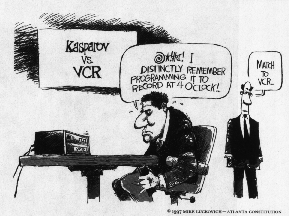
At home I used to have a very intelligent VCR with near-perfect voice recognition and knowledge of me. I could ask it to record programs by name and, in some cases, even assume it would do so automatically, without my asking. Then, all of a sudden, my son went to college.Nicholas Negroponte, Being Digital, pg. 91.
Negroponte's joke reflects a sad truth not only concerning VCR interfaces but about modern technology as a whole. In our day-to-day activities, we are confronted by numerous examples of feature-rich devices that are either too complex or confusing for most of us to operate successfully.
The UbiComp VCR (QuickTime video) is a research project aimed at simplifying the use of one of the most notorious examples of overly complex technology. We make use of a flexible and adaptive speech interface to allow users to specify programs to record (by name, and/or other constraints) and learn the users's viewing habits over time, so that favourite programs can be scheduled for recording automatically, for example, when the user is unexpectedly away from home.
In order to provide an alternative to the many other functions that currently overload our remote controls, we make use of a single-button pointer or wireless mouse to select from a set of context-relevant icons on screen. These can be invoked at any time, either as a manual override for default behaviour, or as a means of "training" the VCR.
While the speech interface is an elegant alternative to the cumbersome process of on-screen programming, the question remains as to how much effort is required to learn the command syntax. It is our belief that the vocabulary base of the VCR must be flexible and adaptive. Users should not need to learn a specific command to interact with the device; instead, the VCR should ask the user to perform a given task manually when a command is not understood. At that point, the VCR can learn to associate the relevant spoken words with the appropriate command.
Another aspect of this research was the prototyping of a visual tape database that helps users find the tape containing an earlier recorded program and also, locating the desired segment on a specific tape. Sony Corp. incorporated this technology into their next generation of VCRs.